What are an epilation and depilation?
Epilation and Depilation or how to find a way in the jungles of beauty?
Let’s start with the epilation and its types:
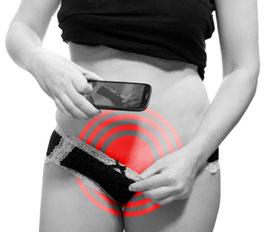 1. Photo-epilation
1. Photo-epilation
Hair contains melanin pigment which can absorb and conduct the light. This is the base of the photo epilation. Absorbing the energy of a light impulse, melanin provokes heating and destruction of a hair follicle. As a result, hair leaves the treated area. What’s more, each flash of light kills several follicles at once.
Advantages:
- It doesn’t matter what color your hair is: dark or red – photo epilation will kill all of them (blonde hair will need more flashes);
- Estheticians claim that hair disappears almost painless and for good;
- You can do it on any skin area;
- Flash parameters are adjusted for each client;
- There’s no contact with skin;
- The damage to skin is minimal;
- No risk of infection;
- There’s a nice side effect: due to collagen producing stimulation, the skin rejuvenates.
Disadvantages:
- Photo-epilation won’t help with gray hair;
- Young women with dark skin sometimes get rash similar to the teenage acne (it usually disappears during next 7 days without any special treatment);
- Eyebrow photo epilation can negatively affect one’s sight if no proper eye protection is worn;
- Photo-epilation can provoke pigmented lesion, making light or dark spots appear on one’s skin;
- Photo-epilation can affect the body perspiration: sometimes the respiratory glands are damaged along with hair follicles.
Contraindications:
- Acute allergic skin reactions;
- Acute exacerbation of a chronic disease (eczema, psoriasis, lichen acuminate, ichthyosis, atopic dermatitis, lupus erythematosus, systemic sclerosis, bullous dermatosis, collagen diseases, vasculitis, dyschromia);
- Ischemic heart disease and hypertension;
- Herpes in an acute phase;
- Varicose veins;
- Keloid scars;
- Skin tumors, malignant diseases;
- Acute infectious diseases;
- Parasitic diseases (helminthiasis, dermato-zoonosis);
- Pregnancy and breastfeeding.
Time: one procedure lasts from 10 min to 1 hour. The time between procedures is 2 to 8 weeks.
Result: I’d be frank, one procedure won’t kill hair once and for all, as they grow in turn. The ones that are visible are 30% of all hair in its active phase of growing. That’s what will be removed in one procedure. They won’t appear again (if the procedure is done professionally). Then the next portion of hair grows, the next 30%, and so on. Estheticians claim that the desired effect can be achieved in 3-7 procedures. But after the very first procedure, you will already notice that the hair started falling out, and the new portions of it appearing are weaker and thinner. Nevertheless, as practice shows, despite all ads’ claims, the photo epilation is not a panacea.
Notes: you shouldn’t sunbathe 3 - 4 weeks before the procedure and ten days after.
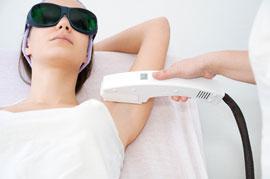 2. Laser epilation
2. Laser epilation
It’s very similar to the photo epilation, but the hair follicles are being destroyed by a laser. The laser has a certain light wavelength. For example, the wavelength of a ruby laser reaches 694 nm, an alexandrite one produces 755 nm waves, a diode laser - 800 nm, a neodymium laser - 1064 nm. Thus the laser sends a wave of a certain length, say, 755 nm, while the equipment for the photo epilation IPL (Intensive Pulse Light) forms a light beam with a wide wave range (500-1200 nm), treating the bigger area. But the light beam is weaker than the laser one.
Advantages: the same as the photo epilation has, but it also destroys lanugo, gray, blond and red hair as it doesn’t depend on the melanin.
Disadvantages: the laser epilation cannot be done on the tanned skin (the diode laser is an exception).
Contraindications:
- Diabetes;
- Herpes in an acute phase;
- Acute infectious diseases;
- Pregnancy;
- Dark skin or recently tanned skin.
Time: the same as the photo epilation.
Result: See photo epilation.
Notes:
- Avoid plucking and waxing a month before the laser epilation;
- No tanning lotions a week before the procedure;
- No sunbathing during a couple of weeks before and after the procedure;
- A couple of days before the procedure you need to shave the hair on the area that will be treated;
- 4-5 days after the procedure your skin will be very sensitive so be careful with any mechanical influence;
- After the laser epilation, you might see a false hair growing, but it’s only dead roots that are surfacing. They are easily removed with tweezers.
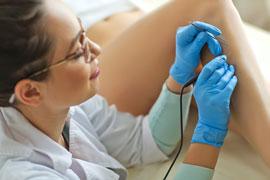 3. Electrolysis
3. Electrolysis
The electric tweezer method.
Electric current is applied to a very fine needle-shaped electrode, or metal probe into each hair follicle to destroy the root. The needle-shaped electrode can be made of medical alloy: an isolated one, with a Teflon coating for people with low pain tolerance; golden one – for people with allergies).
There are several methods of Electrolysis: Electrolysis itself, thermolysis, blend-method, flash-method, sequential blend. But I won’t continue naming them not to overload you with information.
So, the advantages of the electrolysis are:
- Over the time it removes hair forever, even if its growth is a result of a hormonal disbalance;
- The color of hair to be treated doesn’t matter;
- Electrolysis eliminates the risk of ingrown hair;
- It’s a relatedly cheap procedure.
Disadvantages:
- It’s very painful;
- Local anesthesia can lead to the inverse effect: hair will grow in the area that was anesthetized;
- It’s not recommended to do it in the underarm area, and it’s forbidden to do it on nose and ears;
- Electrolysis damages the skin and can result in skin infection and scarring;
- After the procedure, a local redness and swelling may develop which disappear after a couple of hours usually; also red dots can appear on the skin that turns into the scab and soon disappear.
Contraindications:
- Varicose veins;
- Keloid diseases/papillomas;
- Neuropsychic diseases, epilepsy;
- Decompensated diabetes;
- Certain forms of hepatitis;
- Infectious diseases;
- Sever ischemic disease and high blood pressure;
- Idiosyncrasy of metals that needles for electrolysis contain (golden, nickel) and of electricity;
- Dental posts, orthopedic implant, and cardiac pacemaker;
- Implanted gold thread;
- Intrauterine device (IUD);
- Pregnancy.
Time: from 15 mins to 1 hour per procedure.
Result: from 5 to 10 sessions to remove the maximal amount of unwanted hair.
Notes:
- Hair must be at least 1/4” long;
- If you chose electrolysis to remove unwanted hair, keep using only this method, don’t use other ways of hair removal;
- If you have dry skin, we recommend exfoliation to remove the dead skin cells from the area to be treated;
- During next three days after the hair removal, don’t expose treated skin to the sun (don’t sunbathe);
- During a week after the procedure, we do not recommend using sauna and pool.
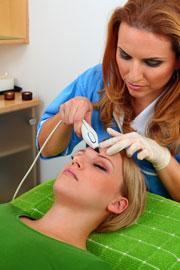 4. Ultrasonic hair removal
4. Ultrasonic hair removal
The first stage of this procedure is sugaring/waxing. During the second stage, a special gel is applied, and then the skin is treated with an ultrasound. As a result, molecules and ions of the gel penetrate the skin deeply. If hair follicles are in its active growth phase, they will be destroyed. If the hair follicle is in quiescence, the growth of a hair slows down.
Advantages:
- It’s painless;
- Helps to get rid of light, thin and even gray hair;
- Allows to remove hair in hard-to-get-at places like ears and nose;
- The relatively low cost was comparing to other types of epilation.
Disadvantages:
- Doesn’t destroy hair follicles, but slows down the hair growth;
- Along with embryo-cell, other tissue cells are being killed;
- Possible skin damage;
- Is not recommended for the bikini area.
Contraindications: idiosyncrasy.
Time: the procedure lasts from 10 to 30 minutes.
Result: first procedure destroys hair in the active phase of growth. 6-10 sessions (with a month between the procedures) allow getting rid of 70 - 90% of unwanted hair.
Notes:
- The length of hair should be 0,2-0,8 inches;
- We do not recommend sunbathing after the procedure.
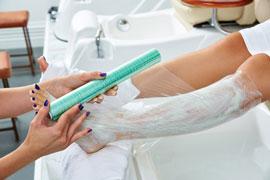 5. Enzymatic epilation
5. Enzymatic epilation
The first stage of this procedure is sugaring /waxing. During the second stage, the designated area is treated with the enzyme-containing mixture. Then the skin is covered with special thermo-bandage and treated by infra-red rays. As a result ferments from the mixture penetrate hair follicles and destroy them, interfering with the metabolism in the area of hair growth, and killing hair follicles. After infra-red ray treatment, the practitioner removes the bandage and treat the area with enzyme-containing lotion. It soothes skin and, what’s the most important, slows down the hair growth.
* Enzymes or ferments (trypsin, papain) are bioactive substances that are very effective, safe for your body and are used for the cosmetic purpose to remove unwanted hair.
Advantages:
- It’s painless;
- Relatively cheap;
- Wide areas can be treated at once;
- It’s possible to use it on sensitive skin;
- Makes newly growing hair thinner and weaker.
Disadvantages:
- Cannot be used for face hair;
- Doesn’t destroy hair follicles;
- The procedure should be repeated every month.
Contraindications:
- Pregnancy;
- Varicose veins;
- Pus and inflammatory skin diseases;
- Severe heart diseases;
- Cancer;
- Individual skin reaction on enzymes;
- Diabetes;
- Period.
Time: the length of the procedure is 40-50 mins.
Result: after the first procedure the newly growing hair becomes weaker and thinner. The desired effect takes from 4 to 7 procedures.
Notes:
- To avoid serious allergic reaction, we recommend trying the mixture on a small area of skin a day in advance;
- Use special sun protection lotion to protect your skin against ultraviolet rays;
- Do not sunbathe or visit Sun booth two weeks after the procedure;
- Use depilation creams to remove newly growing hair to avoid the ingrowing.
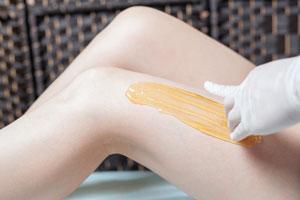 6. SUGARING (sugar depilation)
6. SUGARING (sugar depilation)
The practitioner applies sugar paste that looks like transparent clay (it is usually made of sugar or fructose) and with a quick move tear the hair stuck to the paste off, along with the hair growth. Then a soothing lotion is applied.
Advantages:
- Non-allergic (biologically natural product);
- Cheap;
- Low possibility of skin damage;
- No ingrown hair;
- It allows removing hair from any skin area including face;
- Sugaring also has an exfoliation effect leaving skin smooth and silky.
Disadvantages:
- Painful (it’s a relative disadvantage as a lot depends on the individual pain tolerance, but it’s less painful than waxing)
- A little skin irritation possible;
- Redness that usually disappears in several minutes.
Contraindications:
- Decompensated diabetes (due to the risk of damaging thinned and weak skin, not the sugar itself);
- Pus and inflammatory skin diseases;
- Allergic reactions (redness);
- Open wounds, deep grazes.
Time: the procedure takes from 30 mins to 1 hour.
Result: smooth skin for 10-25 days. We recommend repeating the procedure every 40 days. After a couple of years of regular sugaring, unwanted hair stops growing.
Notes: Do not remove hair for 2-3 weeks before the procedure, so their length is not less than 1/8"-/4".
 7. Waxing
7. Waxing
Wax is warmed up and applied to the growth of hair over the designated area. On top of it, a textile or paper strip is applied. When the wax cools down, the strip with wax and hair is removed by a quick jerk.
For those who are afraid of burns, there’s a procedure of cold waxing. But it’s more painful.
Advantages:
- Non-allergic;
- Cheap;
- Can be done on any body part.
Disadvantages:
- Painful (depends on the individual pain tolerance);
- Hair ingrowth is possible;
- Skin irritation;
- Redness (usually disappears in a couple of hours).
Contraindications:
- Pus and inflammatory skin diseases;
- Diabetes;
- Varicose veins;
- Capillary network;
- Thrombosis;
- Allergic reactions (redness);
- Wounds and grazes;
- Acne.
Time: the procedure usually takes from 30 mins to 1 hour.
Result: smooth skin for 10-20 days. We recommend repeating the procedure every 40 days. After a couple of years of regular waxing, unwanted hair stops growing.
Notes:
- Do not remove hair for 2-3 weeks before the procedure so their length is not less than 1/8"-1/4".
- Before and after the procedure a special disinfectant should be applied on the skin.
- To avoid irritation, a special soothing lotion should be used.
Depilation and its types
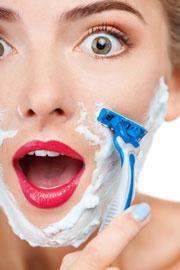 1. Shaving
1. Shaving
It’s the simplest and the most popular method of removing unwanted hair in the world. Shaving is done with the help of a razor.
Advantages:
- Painless;
- Simple;
- Cheap;
- Suitable for any body part;
- Removes hair of any length.
Disadvantages:
- Results in irritation (especially in the bikini area);
- Often leads to numerous ingrown hairs;
- The effect doesn’t last long.
Contraindications: Pus and inflammatory skin diseases.
Time: depends on.
Result: As I mentioned above, it’s a very short-term one. Hair continues to grow, and new ones appear above skin in 1-2 days after shaving.
Notes: Treat your skin with moisturizing lotion after you shaved.
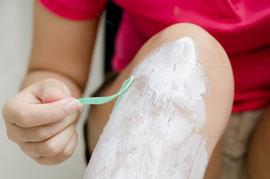 2. Chemical depilation
2. Chemical depilation
Special depilation creams destroy the protein based structure of hair. The cream is applied on the designated area, then using a pallet or a sponge it’s removed from the skin together with unwanted hair. After the procedure, the soothing lotion is applied.
Advantages:
- Painless;
- Cheap;
- Suitable for very sensitive skin areas like bikini zone.
Disadvantages: Very short term effect.
Contraindications: pus and inflammatory skin diseases.
Time: the procedure takes 30 mins in average.
Result: you will get the smooth skin for 1-5 days depending on personal characteristics.
Notes: Before using a depilation cream you need to test it on a small area to avoid chemical skin burns.
 3. Mechanical depilation
3. Mechanical depilation
It’s a mechanical hair removal with the help of special tweezers or electro-depilator that grabs hairs and pulls them out.
Advantages:
- Can be used on different body parts (tweezers removes hairs one by one);
- Long term effect.
Disadvantages:
- Very painful;
- Ingrown hair;
- Skin irritation;
- The procedure is long.
Contraindications:
- Pus and inflammatory skin diseases;
- Varicose veins;
- Allergic reactions (redness);
- Acne;
- Papillomas.
Time: the procedure usually takes from 30 mins to 1 hour.
Result: lasts for 10-15 days. We recommend repeating the procedure once a week. If you do it regularly, hair becomes softer and thinner with time.
Notes: After the procedure, a soothing lotion should be applied.


 Cart
Cart